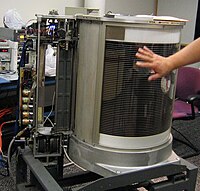
Photo from wikipedia
Abstract Capsule fill-tube target assemblies (CFTAs) for direct drive have been demonstrated in the past for Laboratory for Laser Energetics (LLE) cryogenic layering studies, evolving and building upon successful deliveries… Click to show full abstract
Abstract Capsule fill-tube target assemblies (CFTAs) for direct drive have been demonstrated in the past for Laboratory for Laser Energetics (LLE) cryogenic layering studies, evolving and building upon successful deliveries for the National Ignition Facility [Saito et al., Fusion Sci. Tech., Vol. 55, p. 337 (2009); Johal et al., Fusion Sci. Tech., Vol. 55, p. 331 (2009); Saito et al., Fusion Sci. Tech., Vol. 59, p. 271 (2011); Moreno et al., Fusion Sci. Tech., Vol. 59, p. 46 (2011); and Rice et al., High Power Laser Sci. Eng., Vol. 5, p. 7 (2017)]. The current 100 Gigabar (GBar) Campaign requires tighter specifications over prior CFTA work in terms of robustness and reduced fill-tube diameter and glue spot size, which impact the survivability of the CFTA. To tackle these challenges, General Atomics and LLE are developing a direct-drive CFTA that survives all fabrication activities, from assembly and qualification testing to transport, cryogenic layering, and target chamber insertion at the Omega Laser Facility. Fifty-five CFTAs of three main designs have been constructed and tested to date, building off the current LLE cryogenic layering study of CFTA design (typically 870-μm-diameter × 25-μm-thick wall capsule). Variations of glass fill tube sizes ranged from 30, 20, and 10 µm in diameter. Testing protocols were developed to enable comparison of different designs against one another and to evaluate their robustness at room temperature. The testing protocols include leak checks, resonant vibration mode identification, and vibration survival testing against a power spectral density input. This paper compares the different design trade-offs, measurements, and results including room temperature survivability, ringdown response, leak tests, and scanning electron microscope images taken of failed fill tubes and glue joints. A design recommendation is put forth meeting the design constraints, which consists of a polymicro-composite tube and 10-µm fill tube, ensuring survivability at cryogenic temperature, a higher first-resonance mode, and smaller fuel volume.
Journal Title: Fusion Science and Technology
Year Published: 2018
Link to full text (if available)
Share on Social Media: Sign Up to like & get
recommendations!